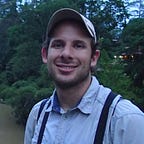What Happened to California Kelp Forests’ Invertebrates?
By Connor Wolf
Heatwaves are not something that only occur on land. These extreme climatic events affect marine life too. A warm blob appeared off of the California coast in 2014, which decimated kelp forests and the animals living there, leaving behind barren environments where only the purple sea urchin thrives.
With a dramatic change of landscape, questions linger on why kelp forest communities failed to recover after this long marine heatwave. The consequences of this event are still being researched as California’s red abalone and red sea urchin fisheries collapsed due to declines in food availability. Additionally, other sessile invertebrate populations have seen significant declines as well as a loss of biodiversity.
A study published by the Marine Science Institute at the University of California, Santa Barbara, Michaud et. al (2022), explores the changes experienced in California’s kelp forests after this infamous marine heatwave. Additionally, researchers strategize efforts to conserve invertebrate populations as climate change increases the likelihood of another marine heatwave impacting California’s cherished coast.
Heatwaves Don’t Just Happen Above the Surface
Similar to air temperatures, ocean waters can experience elevated temperatures for long periods of time. However, such extreme events within coastal water are expected to increase in severity and frequency due to human caused climate change. In 2014, a persistent marine heatwave settled along California’s coast, and the resulting temperatures and length of this unprecedented event became known as the “Blob.”
Similar to how we react to a regular heatwave, marine heatwaves place severe physical stress on sea creatures. The animals most at risk from marine heatwaves are non-mobile and rely heavily on plankton for food. However, warm water temperatures stop nutrient cycling and reduce kelp and plankton (both important food sources) as they need nitrogen to grow, which causes mass starvation for ocean critters.
How Changes Were Monitored
Five reefs off of the Santa Barbara coast were monitored to record the changes of the seafloor invertebrate community. Temperature records at each site were used sensors fixed to the bottom and recorded temperatures every 15 minutes from 2003 to 2021. Marine heatwaves were denoted as days where water temperature exceeded 90% of all temperatures recorded for a duration of five or more days.
Since plankton remain an important food source for marine organisms of interest, chlorophyll levels were used to estimate the phytoplankton levels over time. Bins collected chlorophyll and were calculated to estimate food availability throughout the year. Plankton concentrations were measured once every three months.
Invertebrate communities were surveyed in a permanently marked section of each reef. Each organism was identified and counted toward a percentage cover of the sea floor. Total amount of species (or as ecologists would call species richness) was calculated. Additionally, kelp density as well as red and purple sea urchin densities were recorded.
The 2014 Blob and the Rise of Invasive Invertebrates
Peak temperatures of the 2014 marine heatwave reached +3.1°C above average temperatures, which is equivalent to an average daily temperature of 19.6°C. The abnormal temperatures reduced nutrient circulations and led to significant plankton declines. Thus, with more limited food availability, seafloor invertebrate populations declined 71% during the Blob, with a minimum of cover of 7% in fall 2015. Additionally, the total number of species declined 69% in the same period.
Three years after the marine heatwave, increases in invertebrate cover reached their peak, but the presence of two invasive species (Watersipora subatra and Bugula neritina) accounted for much of this increase. These two invasive bryozoan species (resembling slimy moss) remain hard to control as they have wider tolerances to extreme conditions and thrive in the nutrient rich waters of California. The dominance of these two invasive species after the 2014 marine heatwave could be due to reductions of native invertebrates that would otherwise outcompete these invaders. Other warm water invaders such as the nonmobile worm, Thylacodes squamigerus, have made their way into the Santa Barbara Channel, and this worm can survive long periods of low plankton availability and have a higher tolerance to warm water.
Climate Change’s Implications for California Kelp Forest Invertebrates
With human caused climate change projected to warm baseline ocean temperatures as well as increase the intensity and duration of marine heatwaves, climatic events such as the 2014 Blob may become more frequent in the near future. Therefore, marine conservation efforts to prevent the spread of invasives such as T. squamigerus, W. subatra, and B. neritina remain necessary to keep California’s kelp forests productive and biodiverse.
However, hotter environments may see the northward spread of species from warmer waters into the Santa Barbara Channel, which may outcompete native species still recovering from population declines related to marine heatwaves. Therefore, changes in community dynamics and structure within California kelp forests remain inevitable. Looking toward the future, reductions in carbon emissions and other climate change curbing actions may be the most cost effective and reliable method of conservation.
Work Cited
Michaud, K. M., D. C Reed, and R. J Miller. 2022. “The Blob marine heatwave transforms California kelp forest ecosystems.” Communications Biology 5(1): 1143–1151.
